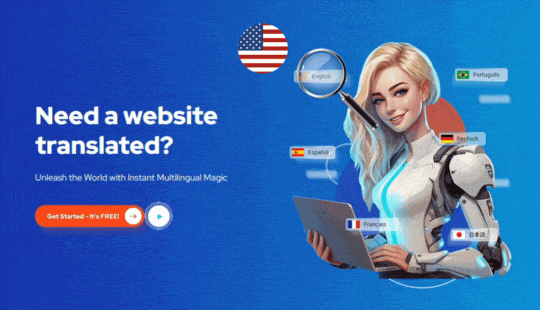4 Key SEO Tips for Multilingual Websites in 2024


Optimizing Multilingual Websites for Search in 2023
Furthermore, optimizing the website’s technical aspects is crucial for multilingual SEO success. Ensure that your website has fast load times, as slow-loading pages can negatively impact user experience and search rankings. Optimize images, enable caching, and consider upgrading hosting services to accelerate page speeds.
User experience plays a vital role in multilingual SEO. Design an intuitive navigation system that allows users to easily switch between languages and find the content they need. Provide language selectors or dropdown menus that are prominently displayed and easy to use.
Another important aspect is localizing your content beyond mere translation. Consider cultural nuances, preferences, and sensitivities when adapting your messaging, visuals, and user interface. Localization enhances the user experience and establishes a stronger connection with the target audience, leading to better engagement and higher search rankings.
Regularly monitor and analyze your multilingual SEO efforts using web analytics tools. Track keyword rankings, organic traffic, and user behavior to identify areas for improvement and make data-driven optimizations.
Remember that multilingual SEO is an ongoing process. Stay up to date with search engine algorithm changes and industry trends to adapt your strategy accordingly. Regularly audit and update your translated content to ensure its accuracy and relevance.
By implementing these key tactics and continually refining your multilingual SEO strategy, you can maximize visibility, drive organic traffic, and create a positive user experience across different languages and regions.
The Importance of Multilingual SEO
With tools like Yoast democratizing SEO, staying up-to-date on best practices is essential. Although much of the internet uses English, it’s only the third most common native language globally. Optimizing for multiple languages expands your reach tremendously.
Even primarily English-focused sites will have many non-native visiting users. Relying solely on automatic translation fails to deliver an optimal experience. A dedicated multilingual SEO approach is best.


Crafting an Effective Strategy
First, research your target locales to understand unique search habits, social media nuances, content needs and more. Key considerations:
- Language-specific search terms
- International link-building opportunities
- Localized content requirements
- Current traffic sources and goals
- Multilingual ecommerce factors
- Domain name localization needs
- Country-specific SERP formatting
This informed foundation is crucial when optimizing pages for new markets.
Use Dedicated URLs
When creating a multilingual website, it’s crucial to avoid duplicating URLs for each language version. Instead, incorporating indicators like subdirectories is a recommended practice. For instance, the English version of a page can be located at example.com/page, while the French version can be at example.com/fr/page.
This URL structure helps prevent duplicate content penalties from search engines. By differentiating language versions through subdirectories, search engines recognize the unique content and avoid penalizing the website for duplications.
ConveyThis, with its advanced features, simplifies URL management by automatically handling the configuration of language-specific URLs. It ensures that each language version has the appropriate subdirectory structure, contributing to a well-organized and search engine-friendly multilingual website.
By following best practices for URL management and leveraging ConveyThis’s automated capabilities, businesses can effectively avoid duplicate content issues, maintain a strong SEO presence across multiple languages, and enhance the overall user experience on their website.

Implement Hreflang Tags
Hreflang annotations play a crucial role in indicating the target language and region of a web page, especially in multilingual and international SEO strategies. However, manually adding these complex tags can be a challenging and time-consuming task.
Fortunately, ConveyThis simplifies and automates the process of adding hreflang annotations. With its user-friendly interface and advanced features, businesses can easily configure and implement hreflang tags across their website. This automation not only saves valuable time and resources but also ensures accuracy and consistency in indicating language and regional targeting.
By leveraging the power of ConveyThis to handle hreflang annotations, businesses can effectively signal search engines about the linguistic and regional variations of their web pages. This enables search engines to understand and serve the most relevant content to users based on their language preferences and geographic locations. Ultimately, it helps businesses improve their multilingual SEO efforts, increase their online visibility, and reach their target audiences more effectively.

Stick to One Language Per Page
Avoid mixing languages within pages. Consolidating content into one tongue creates a morea
Maintaining consistency and coherence in website content is vital for a seamless user experience. One key aspect is to avoid mixing languages within pages. When different languages are intermixed, it can confuse and frustrate users, making it difficult for them to navigate and understand the content.
To create a more cohesive user experience, it is recommended to consolidate the content of a page into a single language. This approach ensures that users can fully comprehend the information presented without any language barriers. By doing so, businesses can enhance user satisfaction, reduce cognitive load, and improve overall engagement.
ConveyThis is a valuable tool in achieving this goal. It offers the capability to translate entire pages into the desired language, allowing businesses to maintain consistency throughout their website. By utilizing ConveyThis, businesses can ensure that each page is accurately translated, providing a cohesive experience for users browsing in different languages.
Localize Metadata
In multilingual SEO, it’s not enough to simply translate the content of a website. Paying attention to SEO-critical elements such as meta titles, descriptions, and other text is equally important. These elements directly impact how search engines perceive and rank a website in different languages. To optimize them, it’s necessary to translate them accurately while also tailoring them to resonate with local searchers.
This involves using language-specific keywords that are commonly used by the target audience when conducting online searches. By understanding the local language and search habits, businesses can ensure that their meta titles, descriptions, and other SEO-critical text align with the preferences and search behaviors of their target market in each language.
The process goes beyond literal translation, as it requires careful consideration of cultural nuances, idiomatic expressions, and keyword research specific to each language. By taking this approach, businesses can effectively communicate their message, improve their visibility in search results, and increase organic traffic from diverse linguistic markets.


Speed Up Page Load Times
In addition to translation and localization, optimizing website performance is crucial for multilingual SEO rankings. Faster load times have a positive impact on user experience and search engine rankings. To achieve this, it’s essential to optimize images by compressing them without sacrificing quality.
Enabling caching allows browsers to store certain elements, reducing the need for repeated downloads. Upgrading hosting services can provide better server response times and improved reliability. Implementing these strategies and more, such as minimizing code and utilizing content delivery networks, helps accelerate website speeds, enhancing user satisfaction and ultimately boosting multilingual SEO rankings.
ConveyThis Boosts Multilingual SEO
ConveyThis is a powerful tool that not only translates entire websites with ease but also optimizes them for multilingual visibility. It takes care of crucial technical aspects such as URL management, hreflang tags, and metadata localization automatically. By streamlining these processes, ConveyThis simplifies the translation and localization workflow, saving time and effort for businesses aiming to reach a global audience.
However, ConveyThis goes beyond mere translation by enabling businesses to craft locally optimized content that resonates with foreign searchers. It recognizes the importance of tailoring content to specific cultural contexts, ensuring that it is not only accurately translated but also culturally relevant and engaging. This approach helps businesses unlock their brand’s global SEO potential by increasing visibility and attracting organic traffic from different regions.
With ConveyThis, businesses can seamlessly expand their online presence across linguistic and cultural boundaries. By providing a user-friendly interface and powerful features, it empowers organizations to effectively communicate their brand message in multiple languages, connecting with diverse audiences around the world. Whether it’s attracting new customers or strengthening relationships with existing ones, ConveyThis helps businesses unlock new opportunities and expand their global reach.
Focus on Quality Translations
While machine translation has made significant advancements, it still requires human refinement for optimal results. It serves as a valuable starting point in translating content, but it’s essential to review critical passages to ensure that the tone and meaning are accurately conveyed and smoothly translated. Machine translation algorithms may struggle with nuances, context, and idiomatic expressions, which can lead to inaccuracies or misunderstandings.
Human involvement in the translation process helps ensure that the intended message is effectively communicated and aligns with the desired tone in the target language. By reviewing and refining critical passages, we can enhance the quality and clarity of translations, facilitating seamless cross-cultural communication.


Understand Cultural Differences
When it comes to global communication and branding, understanding the cultural nuances and preferences of different regions is crucial. Color associations, imagery, and messaging can vary significantly across cultures, and what may be perceived positively in one locale could have negative connotations in another. To ensure effective communication, it is important to adapt visual assets to suit each specific culture.
This process, known as localization, involves tailoring content to resonate with the target audience by considering their cultural values, symbolism, and preferences. By localizing content accordingly, businesses can foster stronger connections, avoid misunderstandings, and create impactful and culturally sensitive brand experiences worldwide.
Translation, far more than just knowing languages, is a complex process.
By following our tips and using ConveyThis, your translated pages will resonate with your audience, feeling native to the target language.
While it demands effort, the result is rewarding. If you’re translating a website, ConveyThis can save you hours with automated machine translation.
Try ConveyThis free for 7 days!

